Growing Tomatoes (Organically) – 11 Tips for Success
We have a love affair with growing tomatoes. That first taste of a perfectly ripe, fresh off the vine, sun-warmed tomato is pure awesomeness!
We’ll take you through growing tomatoes from planting to harvest without chemicals, plus companion plants and organic fertilizer tips to give you tons of tomatoes.

Even if you’re not a fan of fresh tomatoes, homemade spaghetti sauce, salsa and ketchup may make you a believer.
Growing Tomatoes – From Planting to Harvest
If you’re starting tomato seeds, please see “Grow Tomatoes from Seed” for tips to produce healthy seedlings ready for the garden.
When you’re ready to plant tomatoes in the garden (or a container), here are the main steps from planting to harvest.
- Start with healthy young plants.
- Choose a growing location with full sun (at least 6 hours of sun) and a soil pH between 6.2 and 6.8.
- If soil is cold, heat it up by covering with landscape fabric or black plastic mulch. Soil temp should be at least 60F (15.5C) in the daytime.
- Amend the garden soil in the planting hole with organic matter and calcium.
- Plant tomato seedling deep after risk of frost is past. Tomatoes will grow a new root system from the buried stem.
- Mulch plants to maintain even soil moisture, prevent diseases, and keep fruit clean.
- Install a trellis, stake or cage to provide support for the plant.
- Add tomato companion plants to help with pests and diseases, and improve pollination.
- Water regularly and deeply at ground level, about 1 inch per week.
- As the plant gets larger, remove the bottom leaves.
- Harvest ripe tomatoes and store at room temperature.
Choosing the Right Tomato Seedlings
Avoid big plants in tiny pots, and tall, floppy plants. They are probably root bound (too many roots in not enough space). This causes stress to the plant.
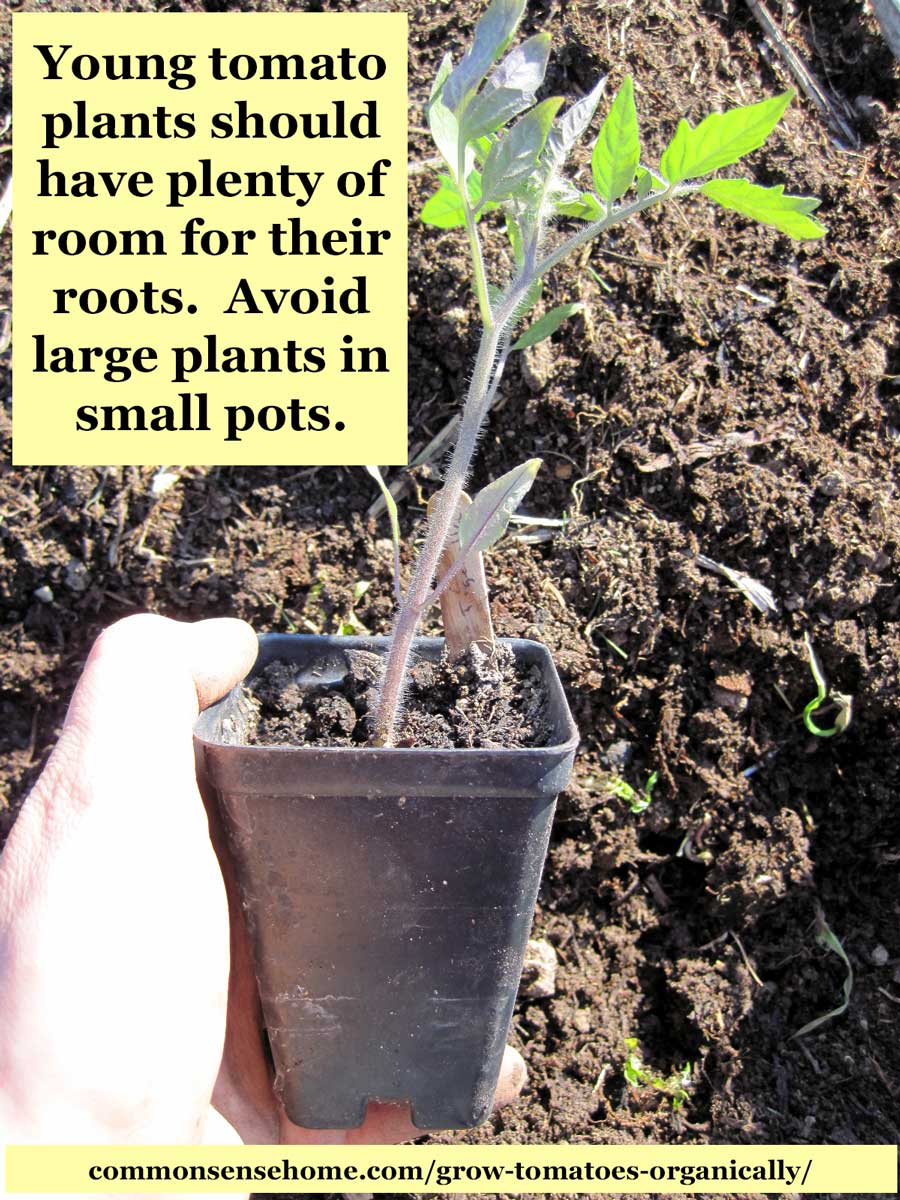
There are two main types of tomatoes (based on how they grow).
Determinate tomato varieties grow to a certain size and stop, and tend to ripen all their fruit around the same time.
Indeterminate tomatoes (most heirlooms) will keep growing until frost and ripen fruits over a longer time period. Mine easily reach 6 feet tall. (See tomato supports below.)
Where to Grow Tomatoes
Tomatoes prefer full sun (at least 6 hours), although plants in extremely warm areas may benefit from some afternoon shade.
Frost kills tomatoes, so don’t try growing tomatoes too early. If soil is cold, use landscape fabric or plastic to cover it and warm it up.
Tomatoes like warm weather, so northern growers can improve growth by creating a microclimate for their plants.
Block excess wind from your plants. Use a wall-o-water, or create you own heat trapping wall with old vinegar jugs filled with water.
How Close Together Can I Plant Tomatoes?
If you train your tomatoes to a single main stem up a string trellis, you can plant as close as 15″ apart (37.5 cm). When using other supports or cages, plant 2 feet (60cm) apart. Give unsupported indeterminate tomatoes 3 feet (90cm) between plants.
Plant deep after risk of frost is past.
Prepare a planting hole or trench that is deep enough to bury two-thirds of the tomato stem. Soil temp should be at least 60F in the daytime and 50F at night before planting tomatoes.
Tomato plants grow new roots from the buried stem. Less plant above ground also means less chance of wind damage.
In your planting hole, add:
- a scoop of compost or rotten manure
- a handful of crushed eggshells or 1/4 cup diatomaceous earth for calcium

Loosen any tangled roots as you gently remove the seedling from its pot. Set the seedling in, cover with dirt, and water well.
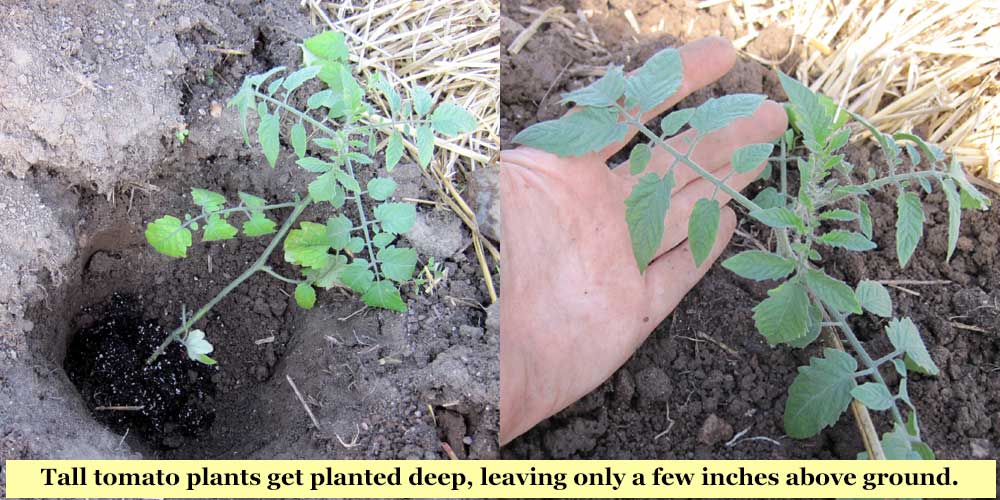
Mulching Tomatoes
We lay down wet newspaper and cover it with straw after the tomato plants are well established. Don’t mulch with straw until you are sure your soil is warm.
If it’s a cold year, I’ll put down black landscape fabric over the straw. I get cleaner tomatoes, more even soil temperature and moisture, and very few weeds. Some folks use black or red plastic mulch for soil warmth.
Tomato Trellises and Supports
Put up a trellis or tomato cage when you first plant your tomatoes, to avoid root damage later on. Make sure whatever you use is well secured. High winds can destroy a tomato patch.
A trellis lets more light and air get to the tomato plants, and makes fruit easier to harvest.
You can read about my system, as well as several other trellis options, in the post “5+ Terrific Tomato Trellis Ideas for Easier Picking and Cleaner Tomatoes“.
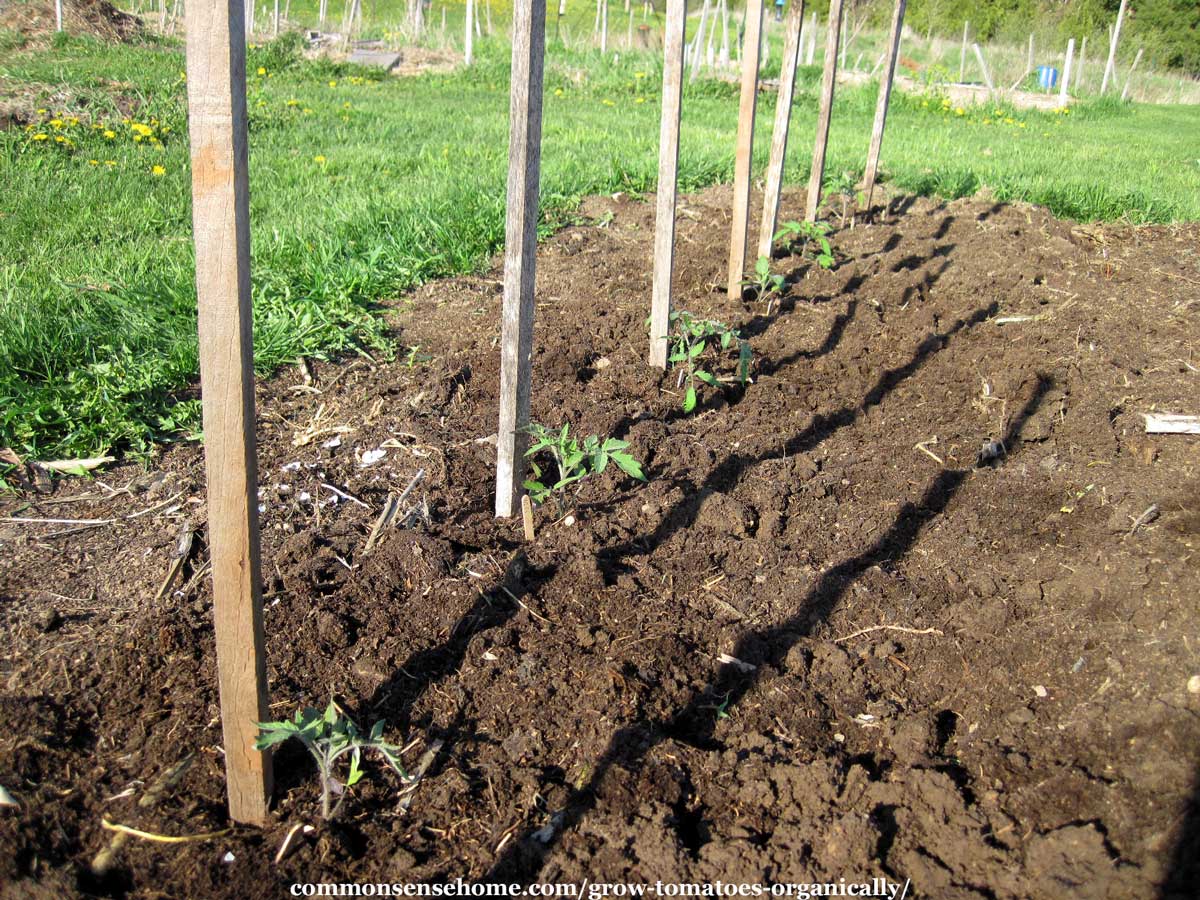
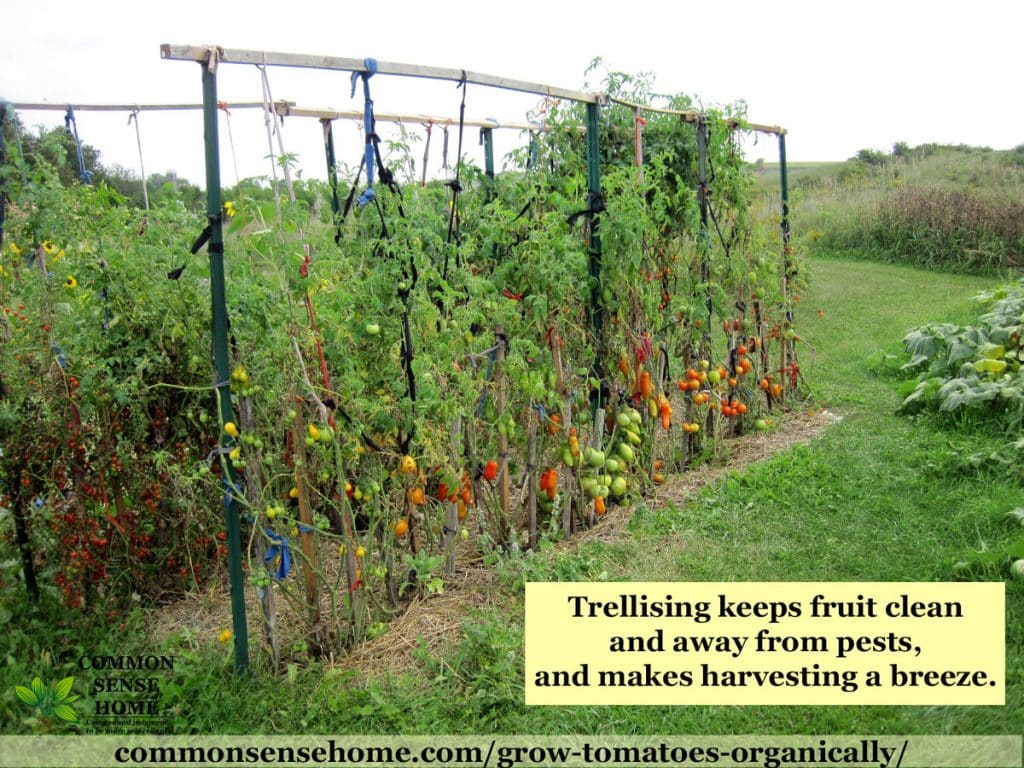
Note top supports. This was not a great growing season, otherwise the plants would have filled the trellis.
Best Companion Plants for Tomatoes
For tomato companion plants, the book Great Garden Companions:
Would you like to save this?
- Basil
- Cleome
- Cosmos
- Parsley
- Queen Anne’s Lace
- Any tall Aster family flower
The Vegetable Gardener’s Bible recommends:
- asparagus
- basil
- bush beans
- cabbage family
- carrot
- celery
- chive
- cucumber
- garlic
- head lettuce
- marigold
- mint
- nasturtium
- onion
- parsley
- pepper
- pot marigold as good companions
They suggest avoiding planting pole beans, dill, fennel and potatoes near tomatoes.
I plant my companions at the end of tomato rows. Planting them next to every plant makes harvest awkward.
Experiment! See what works best in your garden!
How Much Water do you need to Grow Tomatoes?
Tomatoes need about an inch of rain water or equivalent per week. If rains fail, watering plants at ground level is best. Overhead sprinklers may spread fungal diseases.
Lack of water, too much water or irregular watering can cause blossom end rot and cracking.
For more on blossom end rot, check out “7 Steps to Stop Blossom End Rot & Get Rid of Black Bottomed Tomatoes“.
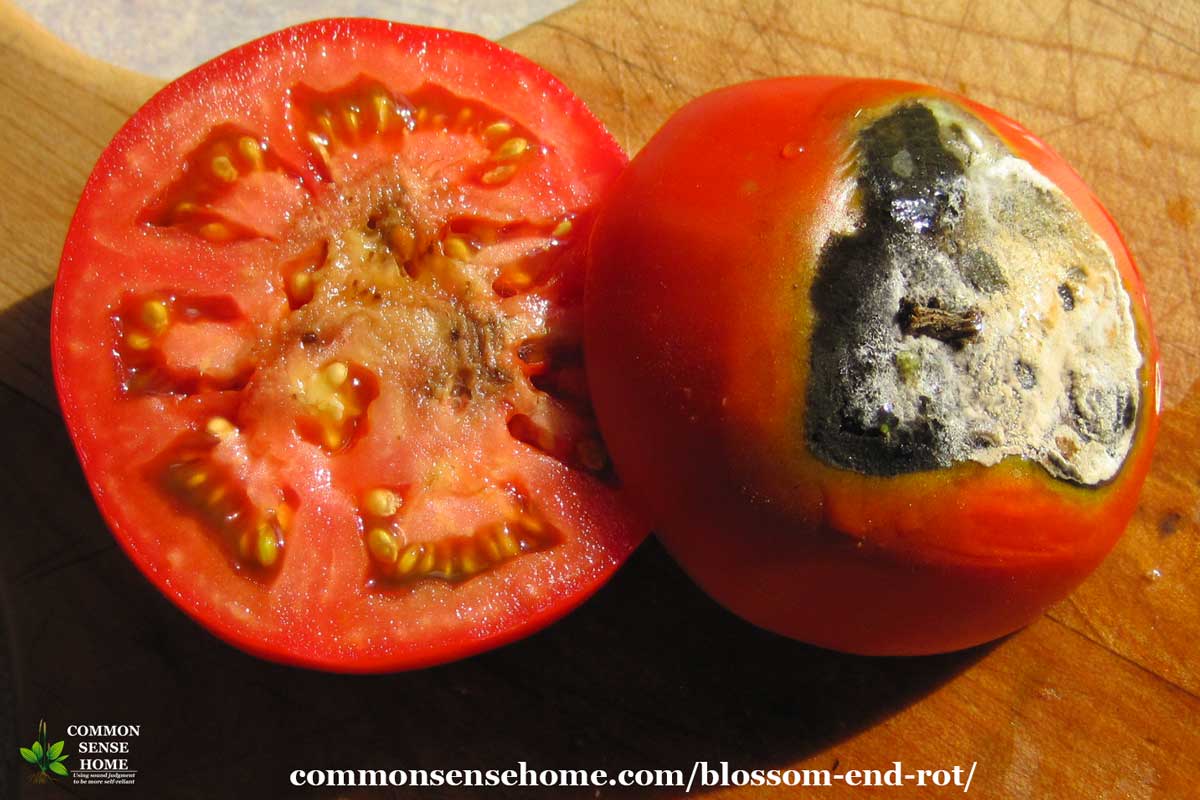
Dealing with Pests and Diseases while Growing Tomatoes
I believe a good offense makes the best defense in the garden. When you are growing tomatoes that are not stressed, pest and disease problems are small.
Many fungal diseases spread up from the soil, so if you remove the bottom leaves of plants, it slows the spread. Mulch also helps to prevent disease spread from the soil.
If tomato hornworms or pecking birds are a problem, try a floating row cover to keep them out. Tomatoes are self-pollinating, so they can still set fruit, but keeping bees out may mean a smaller harvest.
See “Tomato Flowers But No Fruit” for tips to improve fruit set.
Harvesting and Storing Tomatoes
Once your tomatoes turn red (or their expected color), remove them from the vine and enjoy.
Store tomatoes at room temperature, as refrigeration makes them bland and mealy.
Don’t rip or tear the stems when picking – this stresses the plant and opens the path for disease and insect damage. Most tomatoes will have a little knob in their stems, about 1/4 to 1/2 inch above the tomato, where the stem will snap easily in two, releasing the tomato from the plant.
I don’t remove the stem until I’m ready to use the tomato, because sometimes pulling the stem off leaves a big hole.
If you’re growing tomatoes and they aren’t turning red, see”4 Reasons Your Tomatoes Aren’t Ripening“.
For those who want to collect seeds from their tomatoes for next year’s garden, see “How to Save Tomato Seeds“.
Pruning Tomato Suckers
I don’t know how many texts I’ve read that say pinch all your tomato suckers because they don’t produce fruit. This is incorrect.
Now I prune to manage growth and train the plants, and don’t worry about suckers.

Tomato Fertilizers
The Natural Food Garden recommends bone meal or rock phosphate in your planting hole to boost fruit production. They also recommend top dressing the plants with several inches of well aged manure midway through the season.
Foliar feeding every few weeks throughout the season helps to gently meet the needs of growing tomato plants. Try fish emulsion, compost tea, worm casting tea or weed tea.
Compost tea protects plants by coating the leaves with beneficial organisms that crowd out pathogens.
For more information on compost tea, check out The Field Guide II for Actively Aerated Compost Tea.
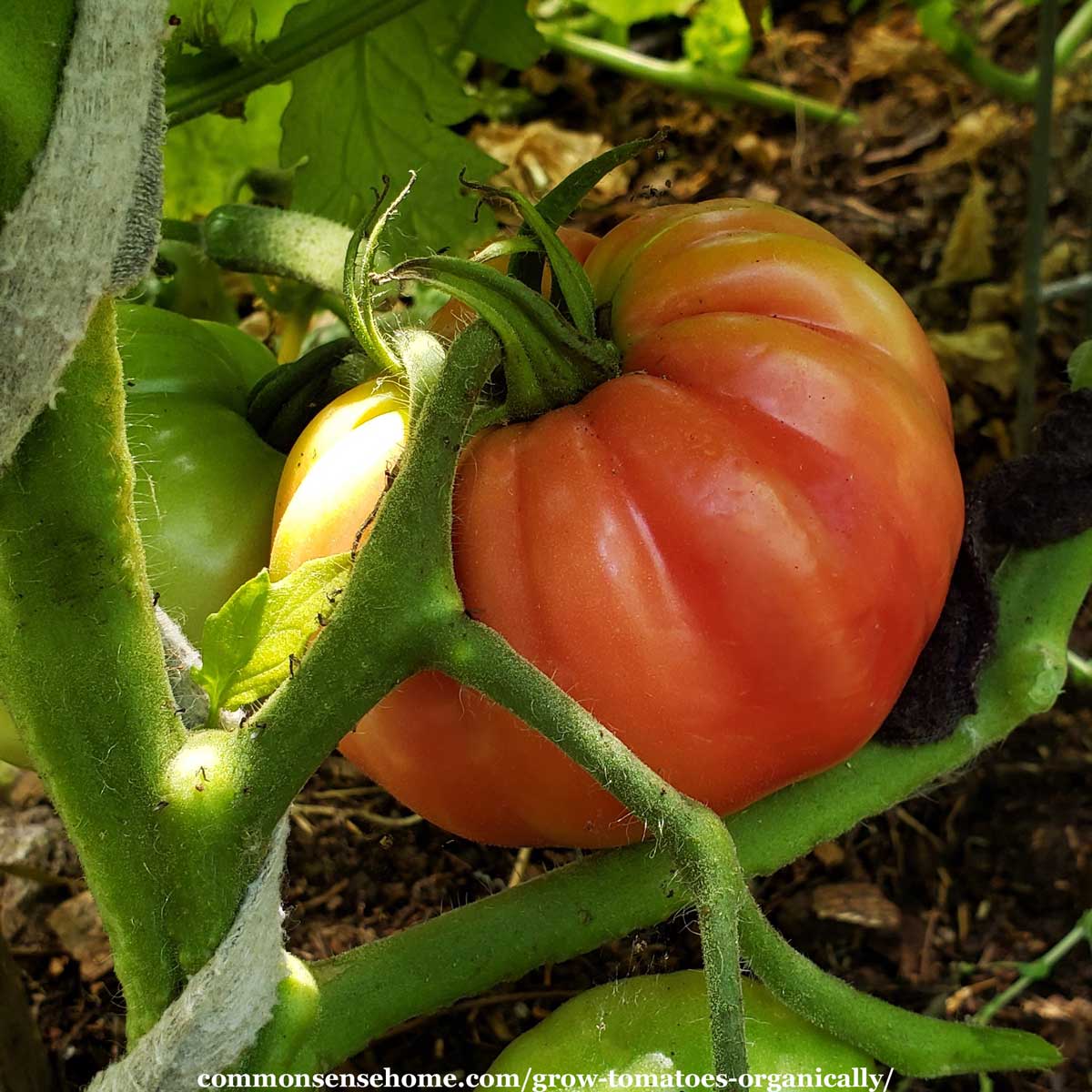
Microbial innoculants such as EM-1 act as plant probiotics. In Building Soils Naturally, they note yields increased by 50% using EM-1.
Biochar dosed with fertilizer helps create long lasting soil fertility.
Music really can help plant grow. Pipe in some classical music while you’re working in the garden (before 10 am is best).
See the article “Music for Plants” for more information.
Comments and questions are always welcome. Don’t forget to take a peek at our other Gardening articles.
Originally published March 2014, last updated May 2020.

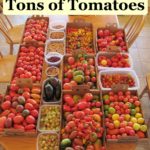

Very interesting. I just want to let you know my easyest own fertilizer
1 Tablespoon Epsom salt disolved 1 gallon water
I use it to water tomatoes once in a month
Epsom salt is made up of magnesium and sulfate – both vital plant nutrients.
Nothing is better than organic homegrown tomatoes 🙂
The tomato plants just grow very tall with alot of flowers but no fruits. What could be the problem?
Sally, there are several potential issues. We have a post in progress that should be up later this week. I’ve been asked this a few times recently, so I figured a post was merited. I’ll add a link here, and I can email you, too, if you’d like. It’ll also go out in this week’s newsletter on Saturday.
The post on tomato blossoms is live at Tomato Flowers But No Fruit, or No Tomato Flowers – 9 Troubleshooting Tips – https://commonsensehome.com/tomato-flowers/
Am challenged abit when it comes the relation of eggshell and growing of tomatoes ,it is agood i dear thanks alot for your teachings.
I don’t measure the crushed eggshells. I scoop about one handful for each tomato to provide calcium to the tomato and help prevent blossom end rot. Agricultural lime will also work. You can read more about preventing blossom end rot in this post – https://commonsensehome.com/blossom-end-rot/
Good luck with your tomatoes.
Really helpful! I was struggling through a long period. Thanks for the advice.
I absolutely love tomatoes, but have never attempted to grow them. The photos in this post make me want to change that today and get a project started.
I’ll have to start with the beginner section in terms of growing tomatoes and the very first point is an interesting one. The use of egg shells for calcium. Will this be required for growing in pots?
There is nothing like tomatoes of varying colours instead of the uniform red that we buy in the shops. Makes a salad very interesting and more appealing.
I might struggle with the frost in the UK as it can get very cold. Hopefully the deep planting will be enough.
Love the tomato trellis by the way. That looks awesome and very satisfying to accomplish.
Will be sure to post back on how this goes for me.
Hi,
Great blog here. But nothing about how to combat the ‘bads’ of tomatoes.
I did everything you said. I have 20 big plants. They are full of tomatoes and of many flowers. I have not sprayed them with anything. Just water them.
The tomatoes turn read but they don’t get soft, and they start to go bad from the middle.
I have some green round bugs and other little black ones collonising them. 🙂 I don’t know if they can be the cause, or maybe only just one of the cause.
Everybody has told me to spray them with a lot of chemical things, but I did not want to. I don’t know if I can save these ones, but what should I use next year?
Thanks.
If I tried to cover everything in one post, I’d have to write a book.
It’s nearly impossible for me to troubleshoot without having more information and being able to see what you’re talking about.
You may be able to find the information you need through Cornell University Vegetable MD – http://vegetablemdonline.ppath.cornell.edu/DiagnosticKeys/TomFrt/TomFrtKey.html
Or through Missouri Botanical Gardens tomato fruit problem solver – http://www.missouribotanicalgarden.org/gardens-gardening/your-garden/help-for-the-home-gardener/advice-tips-resources/visual-guides/tomato-fruit-problems.aspx
How do I access the 2nd article for non beginner growers?
The link is in the text at the bottom of the first page. I just edited it to make it clearer.
Laurie you have an excellent blog and a super resource for growing great tomatoes! Thanks so much for contributing an excellent tomato-growing tip to my blog…you are a value member of our 40 Experts panel.
Hi Dave! Always nice to hang out with you and the rest of the “crew”.
I was curious if you have heard and experimented with permaculture and if so what are your thoughts on it?
I’m just nibbling at the edges of permaculture. I love the idea, but have no experience and no local mentors, so I’m researching and learning as I go. This year we added more nut and fruit trees and shrubs. I keep learning more about using weeds for food and medicine, too, as wild plants are often nutrient dense and darned easy to grow. I just received a couple of new permaculture books from Chelsea Green that focus on my area of the country, so I’m looking forward to reading those. (It looks like I’ll also be giving away copies sometime in November, too.)
One of the most intriguing things about permaculture is the sheer diversity of potential crops, which is something that I find very appealing. Also, to paraphrase Mark Sheppard from Restoration Agriculture, “We need to stop trying to grow things that don’t want to grow, and stop killing things that do want to grow.” I firmly believe that megacrop monocropping is not sustainable or healthy, for us or the planet. I’m really looking forward to learning more and doing more with implementing permaculture on our land.
I’m wondering how close you space your plants? In one of your photos they look quite wide apart, but the photo with the string climbing frame they look much closer. I’ve read varying advice which says to plant anywhere from 1 to 3 feet apart! Which is quite a difference.
I try to keep them at least 3 feet apart, although sometimes they sneak a little closer because I’m trying to squeeze more in. As the season goes on, they easily fill in the whole area.
What is happening if the tomato leaves are curling? Is it a lack of fertilizer, water or a certain nutrient?
Feel the soil. If it is dry, water. Texas A&M has a photographic listing of tomato leaf diseases that may be of help here.
Do you start from seed? If so, do you a start indoors and transplant? Thanks.
Yes, I do start my own plants from seed. You can find more information on that here – https://commonsensehome.com/grow-tomatoes-from-seed/
What ever you do keep the maximum leaves on your plant. This may require a fungicide and some copper. Reasons?
The more leaves, the more food is manufactured for the plant, thus the larger the plant and more tomatoes. The leaves shade the fruit as it ripens and helps prevents cracking, sun scald, and cat facing. Never remove suckers, you are removing leaves as well. Rotate crops to prevent the three major diseases from become rampant. I Fertilize with Potassium Nitrate as well as Calcium nitrate. Yield about 55 tomatoes per plant. About 10% more get thrown out due too Imperfections
Maybe I just missed it….but how to you deal with great horned worms and other pests??
Nope, you didn’t miss it, the post was getting pretty long, so I didn’t get into pest and disease management. The thing is, when my garden plants are healthy, I have minimal problems with pests and disease. If you want the video at all, you’ll see these monster, robust plants. Mine don’t look quite that good, but I have noticed that problems that would have decimated my old garden (where the soil was not as good) barely make an impact here, for the most part.
Tomato horn worms are edible, and considered a delicacy in some areas. (I have not eaten them and do find them a little creepy, but you could eat them.) Poultry love them, too. Typically in a small organic garden they are hand picked, or plants are dusted with Bt (Bacillus thuringensis). Was there another specific pest that’s causing trouble in your area?
I never knew you don’t have to use cages! I hate them too so I’ll have to try building trellis this year. Thx!
You’re more than welcome. My mom used cages, and they were always so awkward to work with.
I hate them too, always wanting to blow over in the storms but I truly love cattle panels! We secure them with T posts and zip ties and they are perfect for our indeterminate crop every year. They are almost indestructible.
Wow! I have never been successful in tomatoes but obviously you are a pro! Look at that harvest. Thanks for the great tips!
This is so, so helpful! I’ve really been struggling with my tomatoes this year. Great advice, thank you!
Thanks for sharing! Hoping I can “help” my green thumb and get a tomato garden in this year!
Second row from the left. I have to know! I see beans, eggplants, and what is in the two containers on the bottom? Thanks for the Post!
Foreground of photo, left to right, Jolly Jester marigolds (gold and red flowers), sweet alyssum (low pale flowers), crystal palace lobelia (blue), peppers, potatoes (top right). Top left corner of photo is a bed of mixed root vegetables.
Oh lol, the photo that says “How to grow lots of tomatoes organically” What are the things in the two containers just below the eggplants? ! 🙂
The table was spread with what came in from the garden that day, but it was mostly tomatoes so I figured it was good for the post. The things below the eggplants are ground cherries, otherwise known as husk tomatoes – https://commonsensehome.com/ground-cherry-lemon-jelly/
Do you pinch “suckers”? My wife and I go back and forth on this. Thanks for the article! -Mike
Nope, not usually! Mostly because I grow so many plants I can’t keep up, and because, in spite what most gardening texts say, suckers sure do produce fruit.
As far as suckers are concerned, they are an easy way to get more plants! Let the sucker grow until it is the size of a #2 pencil. Cut it off at the base and immediately put it into a contain with potting mix in it. The mix can have a little organic fertilizer in it as well. Water the plant in and put it in a bright area but NOT in direct sunlight. The sucker will root within 12+ days and you will have an exact clone of the mother plant.
I do this in my zone 7 garden and plant the sucker in the greenhouse for a (usually) decent amount of fresh tomatoes for the kitchen on up into February, some years.
It depends on whether your tomato variety is “determinate” (sets and ripens fruit nearly all at once) or “indeterminate” (sets some fruit early and continues on through the rest of the season). If you live in a short-season climate, you definitely want to pinch suckers on at least the determinate plants, but probably both, unless you really enjoy green tomato pie (we do).
I grow almost all indeterminate plants, live in a cool climate and prefer not to pinch. Yes, they don’t all ripen before frost, but I have an abundance of tomatoes. It’s a matter of personal choice.
You talked about planting tomato in a garden. So what of if you want to make a large type of tomato farming, will the person also make use of thesame methods that has just been listed here..?
Many of the techniques will be similar, but large scale growers have different methods of managing their crops. Often determinate tomatoes are chosen because they may not require trellising and can be harvested all at once. If trellises are used, pruning and training is often used to keep rows neat and easier to harvest.
Awesome. Congratulations on a well written enthusiastic piece of inspiring guide to follow your bliss.
Just want to “ditto” Andrea’s comment. Excellent.